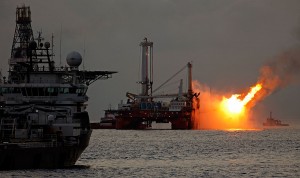The National Geographic website has a new interactive feature on life in the Gulf after the oil spill. The graphic first allows users to select a layer of life that includes: the coastal ecosystems, bright surface, twilight zone, and dark and teeming. Once a user selects the layer they prefer, the site opens up a new picture depicting the different forms of life found in this layer. The user can then select the different plants and animals that live in the chosen layer, causing a description to pop up about its impact on the region and general information on the species. The site allows the user to learn about the different plants and animals that live in the gulf–many of which the average person is not familiar with.
The neat aspect of this interactive map is that it not only gives the user an in depth look at each layer of life, but it also shows how different specifies continue to be affected by the oil spill. The site states that the golf oil spill has, “tested nature's resilience at every layer.”
While the disaster occurred many months ago, the impact on the biodiversity of the region continues to be seriously harmed. It was the largest marine oil spill in the history of the petroleum industry and plants and life forms are still recovering even almost a year later. Many people in the region rely on the productive biodiversity for economic reasons, as thousands of fisheries going out of business. The Gulf Oil spill was something we should never forget, and this interactive map reminds us of how diverse the region is, hopefully leading us to find other places for deep water drilling.
Enjoy the link below to explore life in the Gulf!




This was a really interesting website! I’ve been hearing about the oil spill on and off on the news lately. Though the impacts of the spill are said to be less intense as originally predicted, this website definitely helps in conveying the species impact the spill will certainly have on the gulf.
Considering today is the anniversary for the Gulf Coast oil spill, what better than to comment on the post related to the event. It’s been a year, but it’s amazing how much the catastrophe still affects the biodiversity. The interactive map was useful for me to see what exactly each layer encompasses based on the amount of sunlight. I had no idea the gulf had so much unique marine life, making it one of the most economically and ecologically productive bodies of water. We really do need to focus on conserving marine life (as discussed in class today), especially when catastrophes like the oil spill occur.
I think that this is a really interesting and important website. I feel that often times, when a disaster like the Gulf Oil Spill happens, people tend to forget about the importance of marine life and are instead focuses on issues that effect themselves (like rising gas prices). We can see all of the birds and other species covered in oil on the news and think it is horrible–but we may not do anything about it or feel that we can make a difference in the first place. Websites such as this are great tools to give people an actual understanding of what is going on!